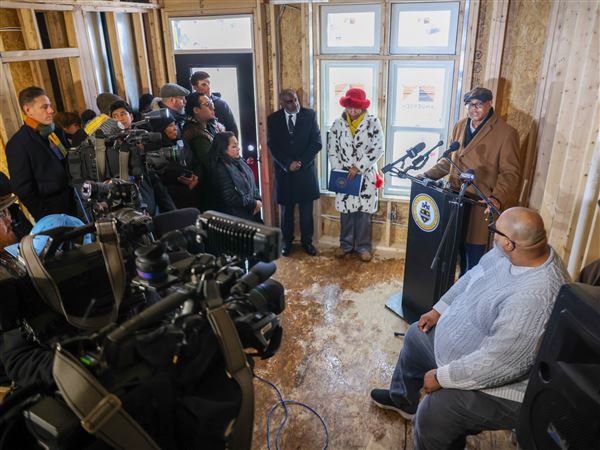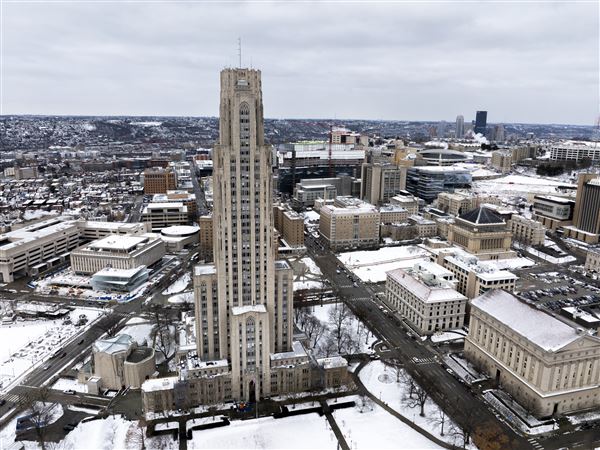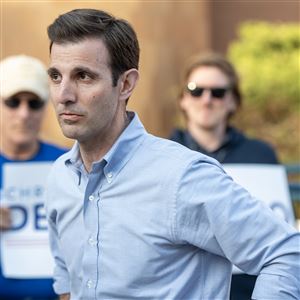In the doorway of a hangar at the Pittsburgh International Airport, Gov. Josh Shapiro on Thursday unveiled a six-part “lightning plan” aimed at increasing energy production, creating thousands of jobs and keeping costs down for Pennsylvanians.
The governor, flanked by many partners in the energy and labor industry, along with federal, state and local officials, coined the name for his six-part plan from Benjamin Franklin — and the well-known story where the inventor tied a key to a kite, flew it during a storm, and was able to discover the electrical nature of lightning.
Mr. Shapiro, a Democrat, unveiled his plan just days before he’s expected to deliver his third budget address. Republicans in Harrisburg, who will be needed to approve various aspects of the plan, have criticized his energy proposals in the past. Still, the governor said Thursday he was confident that his initiatives could take shape if various parties come to the negotiating table in good faith.
If Pennsylvania is to remain on the leading edge of energy creation, then Democrats and Republicans, laborers and environmental groups and others that might typically compete on policy priorities will need to work together, the governor said.
“While I welcome different ideas to the table, suggestions from others — Democrats and Republicans alike — we can no longer afford inaction,” he said. “Simply firing off a press release doesn't actually get people more affordable energy. It doesn't actually put people to work. Now is the time for action.”
Broadly speaking, Mr. Shapiro’s six-part plan aims to streamline permitting and regulatory processes for projects, expand on existing state tax credit programs for those who want to become more energy efficient, and update renewable energy standards.
More specifically, the six parts are:
• Changing aspects of the state’s Economic Development for a Growing Economy, or EDGE program. That program, which offers tax credits aimed to spur investment in energy and manufacturing sectors, needs to be more flexible in order to unlock billions of dollars in impact statewide, the governor said.
• Create the reliable energy siting and electric transition board, also known as the RESET board. The governor said the regulatory process for energy projects, which often involve state and local approval, can take too long for businesses. By creating a single board for such projects, like many other states, it will make Pennsylvania more competitive and move more proposals through the pipeline, he added.
• Updating the state’s energy efficiency programs. Mr. Shapiro said this would encourage consumers to make improvements — in one example, he said more rebates will be available for those purchasing more modern appliances like a fridge or heat pump. Those rebates haven’t been updated in 17 years, he said.
• Adopting a new community energy program that would allow local jurisdictions to work together to create and use more renewable energy. The governor said that would benefit suburban and rural communities. If a Moon Township homeowner doesn’t want to install solar panels on the roof, they should be able to buy it off a local solar grid, he said.
• Reintroduce the Pennsylvania Reliable Energy Sustainability Standard, or PRESS. The governor had proposed that initiative last year, but hopes that this year legislators can work to get the initiative done. It sets energy production goals related to natural gas and renewable energy sources.
• Reintroduce the Pennsylvania Climate Emissions Reduction Act, or PACER. Like PRESS, the governor had introduced this proposal last year. It aims to create a cap on carbon emissions and invest more money within the state.
Multiple speakers Thursday mentioned work at the airport and throughout the region, showing how southwestern Pennsylvania can be a leader in accomplishing the goals of the “lightning plan.”
Stefani Pashman, CEO of the Allegheny Conference on Community Development, an organization focused on economic development in the region, said that having a predictable regulatory environment and better permitting environment were strong aspects of the governor’s plan.
In an interview, she said that the area already has infrastructure in place, thanks to the steel industry and other manufacturing hubs, to pivot to other forms of energy creation. Ms. Pashman said one example was the Homer City Generating Station, a coal plant in Indiana County that closed in mid-2023.
“What could we do with that space? Could we build out some expanded energy production capacity with one of our sources?” she said. “I think that's the question, right? We know how to repurpose infrastructure, so let's look at the siting that we already have here and think about what we can do with them.”
In some ways, the region already has examples of projects that would be created by Mr. Shapiro’s energy package, officials said. Christina Cassotis, CEO of Pittsburgh International Airport, said the facility’s microgrid — consisting of roughly 10,000 solar panels — and natural gas capacity are initiatives that officials can look to for inspiration for other projects.
Labor leaders and elected officials said that similar projects throughout the region and state would result in thousands of jobs, billions of dollars in investment and build on the reputation of Pennsylvania being one of the greatest energy producers in the country.
But there is the question of how President Donald Trump’s administration will be a partner for the governor’s goals. A recent memo and order detailing funding freezes and cuts from the White House sent local governments and organizations scrambling after they realized the fiscal impacts would be considerable — only for the order to be rescinded about 24 hours later.
When asked about potential impacts to his plan, Mr. Shapiro said his administration is looking at all the executive orders that Trump has signed.
“I hope he'll continue to invest in Pennsylvania and build on the investments that were made before, and ensure that we can be energy powerhouses all across the country,” the governor said.
First Published: January 30, 2025, 7:10 p.m.
Updated: January 31, 2025, 8:33 p.m.



















